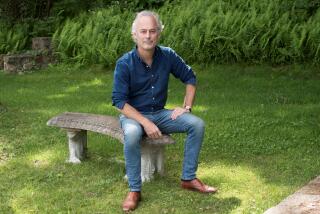‘Ancient Highway’ by Bret Lott
- Share via
Ancient Highway
A Novel
Bret Lott
Random House: 244 pp., $25
At 14, Earl, a middle child in an enormous brood, knows Texas holds nothing for him. He’s fallen in love with “the flickers,” as they called ‘em in the 1920s, and he’s going to make his fortune in Hollywood. To get there, he plans to hop a train. It’s at this moment that “Ancient Highway” opens, with the train bearing down on Earl’s tiny town:
“He’d heard it already, the cold and steady promise way off, building and building but still way off, not yet even to the trestle over Rogers Creek. But coming.” The short first chapter churns like this, the language intensifying with the rhythm of the train’s rush. It’s exciting and tense, and when Earl makes it aboard, his future seems as bright as the stars he watches through the boxcar’s open door.
But pursuing his fortune proves to be a bigger challenge than just getting out of town. Life isn’t easy for Earl, who reaches Hollywood and becomes another hopeful, a faceless member of one of Nathanael West’s crowds. Lucky for Earl, he lacks the Westian malevolence; even when his luck is bad, when he’s working as a janitor and running out of head shots, Earl knows to maintain his smile. Anyone passing might give him a break in pictures.
“Ancient Highway” is the story of Earl and his legacy. The narration moves back and forth across three generations: Earl (in the 1920s and ‘30s), his 9-year-old daughter, Joan (in 1947), and her adult son, Brad (in 1980). Rather than following a traditional plot -- this happens, then that happens -- the book builds its tension by filling in the spaces between the narrators’ alternating stories. What secrets are tucked away? How can this fractured family represented in these separate slices of narrative come together?
The first jump away from Earl’s perspective is jarring -- not just because it’s easy to grow attached to him or because it’s suddenly two decades later but also because Joan lets us see her father’s failings, showing him as an inadequate provider and a neglectful husband and father. Ignoring the fact that his wife, Saralee, is in physical pain and that his daughter silently suffers with her, Earl makes them stand outside Grauman’s Chinese Theatre as he poses, waiting to be noticed by someone, anyone -- still, 20 years later, waiting for his big break. Joan hates Los Angeles and wants to be in Texas with her grandmother. Like her father before her, she knows she’s not where she’s supposed to be.
It’s a trait common to all three narrators. Joan’s son, Brad, also feels displaced, and when he first runs away from her, at 15, it’s back to Los Angeles, to Earl and Saralee. Later, after a stint in the Navy that includes duty in Southeast Asia, Brad is back at his grandparents’ place; whereas the previous generations were determined, he’s at loose ends. “What will happen to me?” he wonders over and over, unemployed and slightly stoned.
By 1980, Earl has mellowed considerably from the man Joan once knew. Earl and Saralee have settled in a house in Pacoima, and Earl, retired, works up small moneymaking schemes -- he recruits Brad to help him sew caftans to sell at the Rose Bowl Flea Market. Setting up there in the pre-dawn gloom, Earl is hailed by nearby vendors as a dear friend, and Brad can’t help but notice their booths of dried flowers and fishing lures and homemade ceramics and wooden wind chimes.
Details of everyday Los Angeles are woven into the story, giving the novel a rich texture. Echo Park and Hollywood make appearances; young Joan rides the streetcar home and recites the roads she passes in a singsong list. It’s at the classic Cocoanut Grove nightclub that Earl meets Saralee.
The one member of this family who doesn’t have a narrative voice, Saralee is in many ways at the center of the story. How does the grandmother that Brad knows, sharp-tongued yet devoted, fit together with the unhappy young mother Joan describes, a woman exhausted by pain? This becomes the central mystery of the novel. Does she have an identity apart from that of wife and mother? And what makes her stick with Earl when his atrocious parenting drives Joan away?
Joan does not come off well; Earl has his dreams and Brad has some generous secrets, but she has little to recommend her. She is less a genuine antagonist than a victim of the book’s structure -- far fewer pages are devoted to her narration than to her father’s or her son’s.
If there is a misstep in this compelling novel, it is in the nature of Saralee’s ailment. She has headaches caused by glaucoma, a condition that must be excruciating. But it is also a bit too poetic; she is losing her sight, and the one thing her husband wants is to be seen. “You never know who you’ll see,” Earl tells his family hopefully, “or who’ll see you.”
Yet the mystery remains. We know, from Brad, that Earl never leaves his modest, anonymous circumstances, telling tales of brushing up against mostly forgotten stars, such as Walter Brennan and Billie Dove. What has become of Earl isn’t particularly important; his desire for fame put untenable pressure on his family, but inverse forces are what drive this novel. What might repair those painful fractures? Is it possible for a broken family to become whole? *
Carolyn Kellogg is the lead blogger for Jacket Copy, at www.latimes.com/books. She is also the host of www.pinkyspaperhaus.com.
More to Read
Sign up for The Wild
We’ll help you find the best places to hike, bike and run, as well as the perfect silent spots for meditation and yoga.
You may occasionally receive promotional content from the Los Angeles Times.











